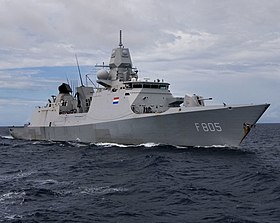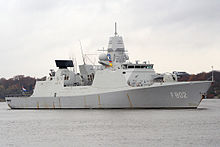De Zeven Provinciën class (frigate)
| De Zeven Provinciën class | |
|---|---|
 Frigate Evertsen (F805) |
|
| Overview | |
| Type | frigate |
| units | 4th |
| Shipyard |
Royal Schelde, Vlissingen |
| period of service |
since 2002 |
| Technical specifications | |
| displacement |
6,050 t |
| length |
144.24 m over all |
| width |
18.8 m over all |
| Draft |
5.18 m |
| crew |
202 (standard) |
| drive |
CODOG system:
|
| speed | |
| Range |
5,000 nm at 18 kn |
| Armament |
|
| Board helicopter | |
The De Zeven Provinciën class consists of four ships of the Dutch Navy classified as frigates . The units put into service between 2002 and 2005 are designed as multi-purpose ships, but the focus is on extensive air defense (AAW) and command and control of fleet units. The first two ships have additional equipment for the latter task. According to the range of tasks, they are also called LCF, which stands for Luchtverdedigings- en commandofregat .
development
At the beginning of the 1980s, the Netherlands took part in the NATO Frigat Replacement for 90s , or NFR-90 for short, project, which aimed to develop a uniform frigate design for all eight participating NATO countries. In the Netherlands, the four ships of the Jacob van Heemskerck and Tromp classes in particular were to be replaced. The project had to be discontinued in 1989 due to the great differences between the needs of the individual navies. The USA built the Arleigh Burke class on a national basis , while Great Britain, Italy and France decided on a new cooperation project, the Horizon Common New Generation Frigate (Horizon CNGF) . The remaining four countries, Spain, Germany, the Netherlands and Canada, had feasibility studies carried out on a national basis. Finally, Spain, Germany and the Netherlands were able to agree on a basic design to be developed on a trilateral basis, which would be built and designed nationally. As part of this Trilateral Frigate Cooperation , or TFC for short, the class 124 was built in Germany , the Álvaro de Bazán class in Spain and the De Zeven Provinciën class in the Netherlands .
All three ship classes built as part of the Trilateral Frigate Cooperation are classified as frigates.
Ship list
All units were built by the Schelde shipyard in Vlissingen , Netherlands and have the abbreviation Zr in front of their name . Ms. or Mr. Ms. what for Zijner / Harer Majesteits schip , in German His / Her Majesty's ship, stands. Outside the Netherlands, however, based on the British abbreviation HMS , HNLMS is often used, which stands for His / Her Netherlands Majesty's Ship .
With the exception of the first, which is reminiscent of the Republic of the Seven United Provinces , the ships were named after Dutch families, each of whom produced several well-known seafarers.
| Identifier | Surname | Keel laying | Launch | put into service |
|---|---|---|---|---|
| F802 | De Zeven Provinciën | September 1, 1998 | April 8, 2000 | April 26, 2002 |
| F803 | Tromp | September 3, 1999 | April 7, 2001 | March 14, 2003 |
| F804 | De Ruyter | September 1, 2000 | April 13, 2002 | April 22, 2004 |
| F805 | Evertsen | September 3, 2001 | April 19, 2003 | June 10, 2005 |
technology
Ship platform
The ships are each 144.24 m long and 18.8 m wide. On the waterline the values are 130.2 m and 17.15 m respectively. The maximum displacement is around 6050 t and the draft is 5.18 m.
The crew consists of 202 people including a staff of 28 people. There is also the possibility of accommodating another 30 people, for example a boarding party can be brought along.
drive
A CODOG system was chosen as the drive . The relatively slow but efficient diesel engines are used for the cruise, while the gas turbines take over the propulsion of the ship for maximum travel. The diesel component consists of two Wärtsilä diesel engines with an output of 5 MW each. For the gas turbines, of which each ship also receives two, you could choose between the LM2500 from General Electric and the Spey from Rolls-Royce . The decision was made in favor of the Rolls-Royce model with an output of 19.5 MW. The power is transmitted via two shafts and two screws with controllable pitch propellers . A rudder roll stabilization system is also installed. This drive system enables a maximum speed of 29 knots and a cruising speed of 18 knots. The range at 18 knots is around 5000 nm.
Four diesel generators from Paxman (subsidiary of Alstom , now part of MAN ) are available for the ships' electricity needs . The power is 1650 kW.
Stealth technology
The De Zeven Provinciën class, like most warships currently being procured or planned, is built according to the stealth principle . This means that the ships are designed in such a way that they are as difficult to locate as possible. As a central point, the so-called radar cross - section is reduced as much as possible. For this purpose, all outer walls must be inclined and made of radar absorbing materials. In addition, special colors and coatings are used to further reduce radar reflection. Rocket launchers, guns, dinghies, etc. must also be disguised accordingly. A second point is the reduction of heat radiation, as this can be located by IR sensors. The main problem here are the exhaust gases, which are therefore mixed with fresh air and cooled before they are expelled. The advantage of these techniques is that the ships are heavier and can therefore only be located later by the enemy. However, despite claims to the contrary, it is not possible to make ships completely invisible for radar location. Also, stealth ships cannot be compared with stealth aircraft such as the Northrop B-2 . Ships are often on mission voyages for months and are constantly exposed to aggressive seawater, which is why many special coatings used in military aircraft construction cannot be used on ships.
Sensors & means of communication
The central elements of the electronics are the two radar systems SMART-L and APAR from the European arms company Thales . The APAR is a three-dimensional multi-purpose radar, which is based on the AESA technology and works in the X-band. Its four non-rotating antennas, each scanning a 90-degree sector independently of one another, are mounted on the higher mast behind the bridge. The Smart-L is a long-range aerial search radar, which is also based on AESA technology and works in the D-band. It is mounted on a relatively small mast above the helicopter hangar.
Furthermore, the ships have the Oberflächensuch- and navigation radar Scout Thales, a Decca navigation radar, a hull sonar type DSQS-24C of Atlas Elektronik , an IFF , the Sirius-IR system from Thales and a FüWES (Combat Management System) from CAMS-Force Vision. All four units have extensive communications equipment, including Link 11 , Link 16 and SatCom. However, the communication equipment of the first two ships is much more extensive than that of the other two, as these are designed as special command ships.
Armament
Guided missiles
The main armament is a Mk 41 Vertical Launching System with 5 × 8 cells. This can fire anti- aircraft missiles SM-2 (long range) and ESSM (medium range). Since the much smaller ESSM can be loaded in a quad pack, i.e. four missiles in one VLS cell, 32 SM-2 and ESSM can be carried. . Because the shorter "Tactical" version was installed the Mk 41 VLS, it is not possible BGM-109 Tomahawk - cruise missiles use. In principle, both the existing cells could be converted to the longer strike version and a sixth module with eight additional VLS cells could be added, since the necessary space was planned for both. These modifications were announced in 2005, but then canceled for cost reasons.
In addition, there are two quad launchers for anti-ship missiles RGM-84 Harpoon and two twin sets of Mk. 32 torpedo tubes for anti-submarine torpedoes of the type Mk. 46 .
Guns
The main gun is the 127/54 Compact from the Italian manufacturer Oto Melara . This is a ship gun in the NATO standardized caliber of 127 mm (5 inches) with 54 caliber lengths . The relatively large caliber offers - in contrast to the other caliber of 76 mm used in NATO - realistic opportunities for land target fire. For dedicated land attack capabilities and in particular the ability to fire GPS- controlled precision ammunition, the further development of this weapon, the 127/64 Lightweight , would have to be procured.
As a final defense against incoming missiles, two goalkeepers - CIWS from Thales are also planned. In order to achieve 360-degree protection, one gun should be mounted at the stern on the helicopter hangar and one at the bow above the bridge. Judging by the pictures, however, only the F805 Evertsen seems to have received both systems, only the rear gun can be seen on the other units.
As the attack on the USS Cole demonstrated, there is a significant threat from attacks by small, fast boats. To enable such ward, are on all ships of De Zeven Provinciën-class frigate, two 20-mm automatic cannon Oerlikon Contraves (now Rheinmetall installed).
helicopter
Each of the ships is equipped to use a helicopter. There is also a 18.8 m wide and 27 m long landing pad at the stern, followed by a hangar that can accommodate a helicopter. The Westland Lynx-type submarine-hunting helicopters currently in use are to be replaced by much more modern and powerful NH90 NFH machines.
Electronic warfare
In addition to the active measures (ESSM, Goalkeeper CIWS), four Mk 36 SRBOC launchers are equipped for radar and IR decoys to protect against approaching missiles . In order to be able to fend off attacking torpedoes, there is a pulled torpedo decoy system of the type AN / SLQ-25 Nixie at the stern . It also has the Thales Saber system for electronic warfare.


